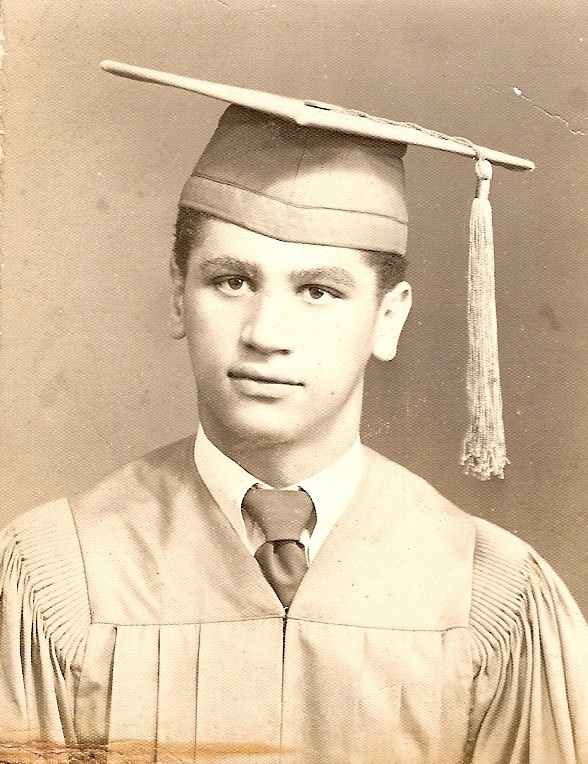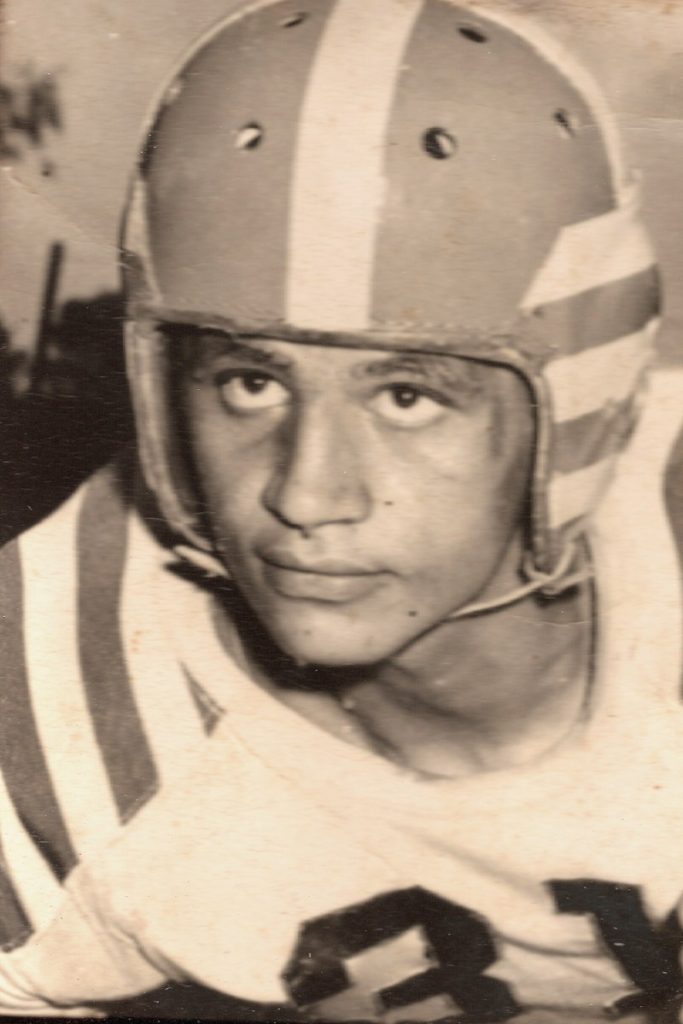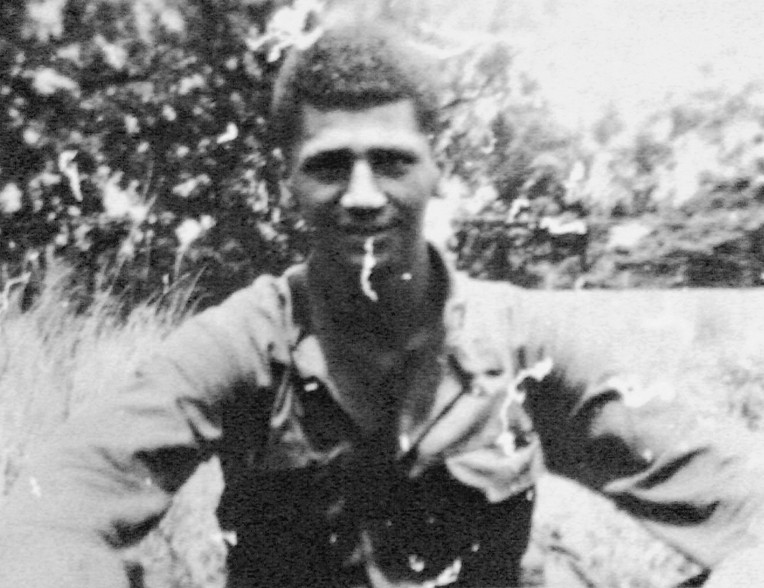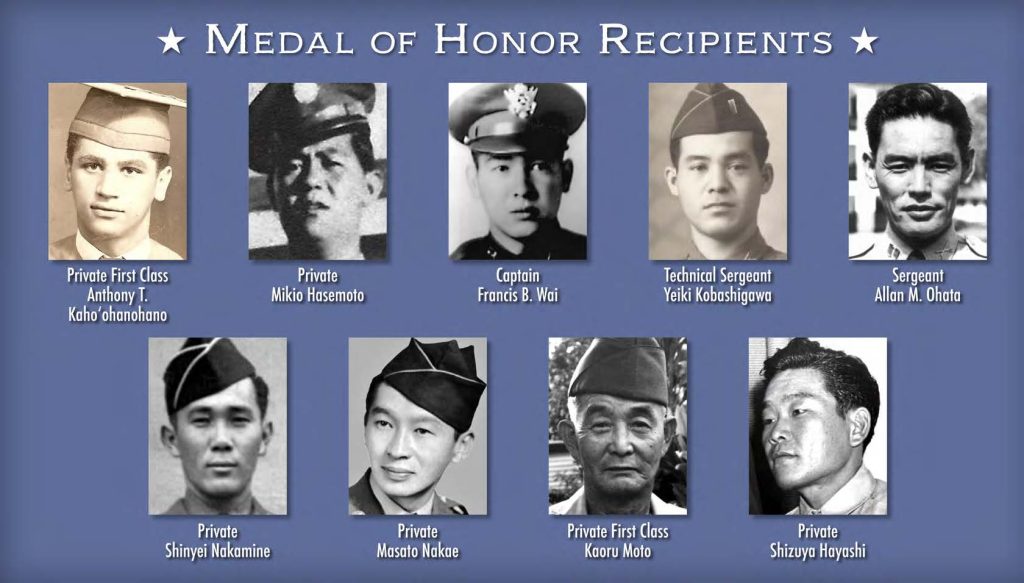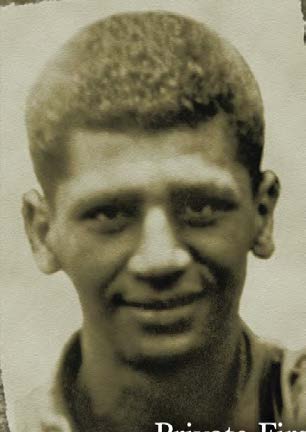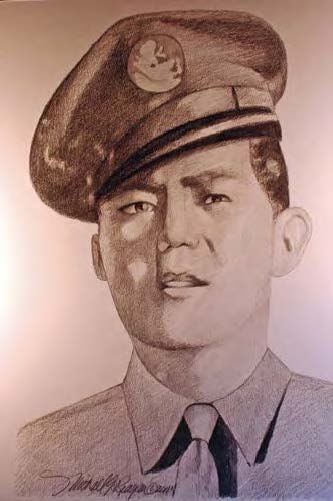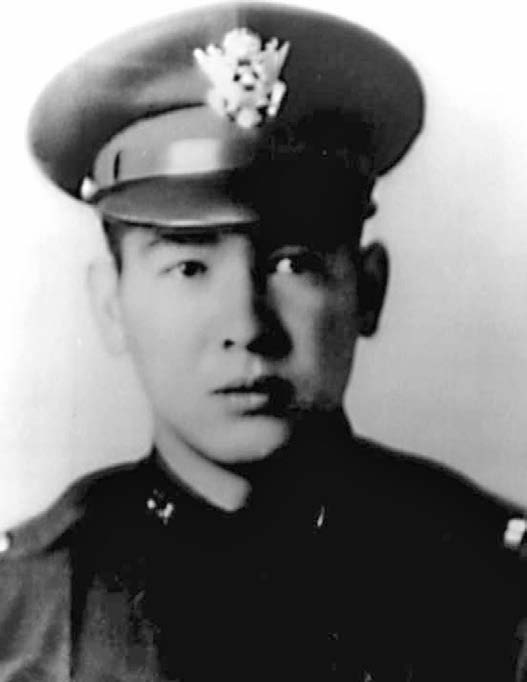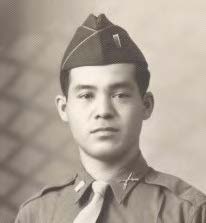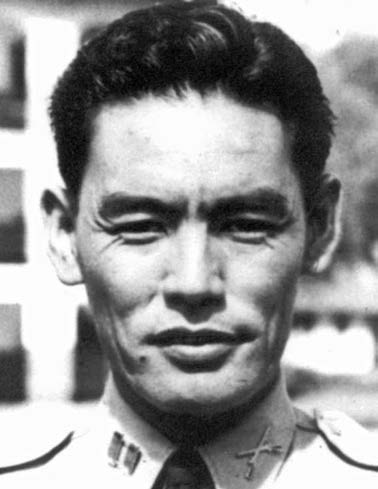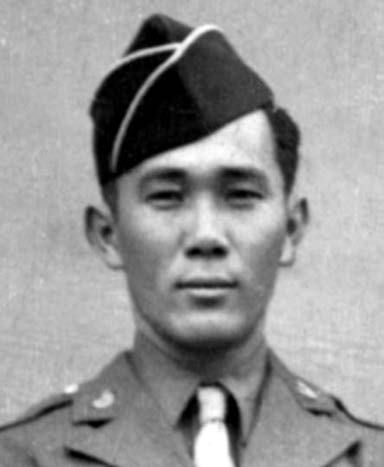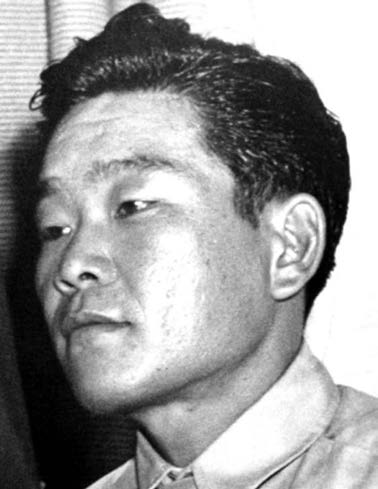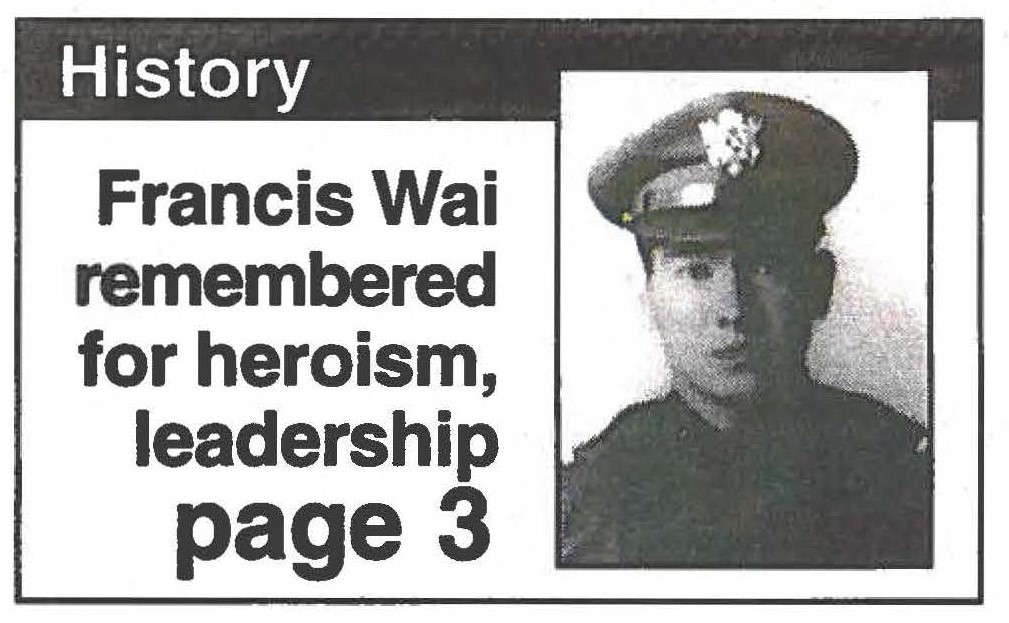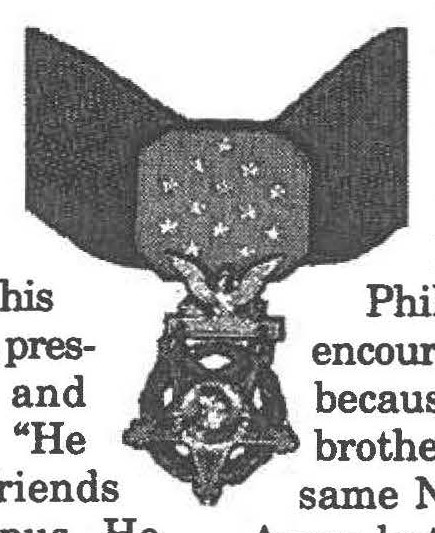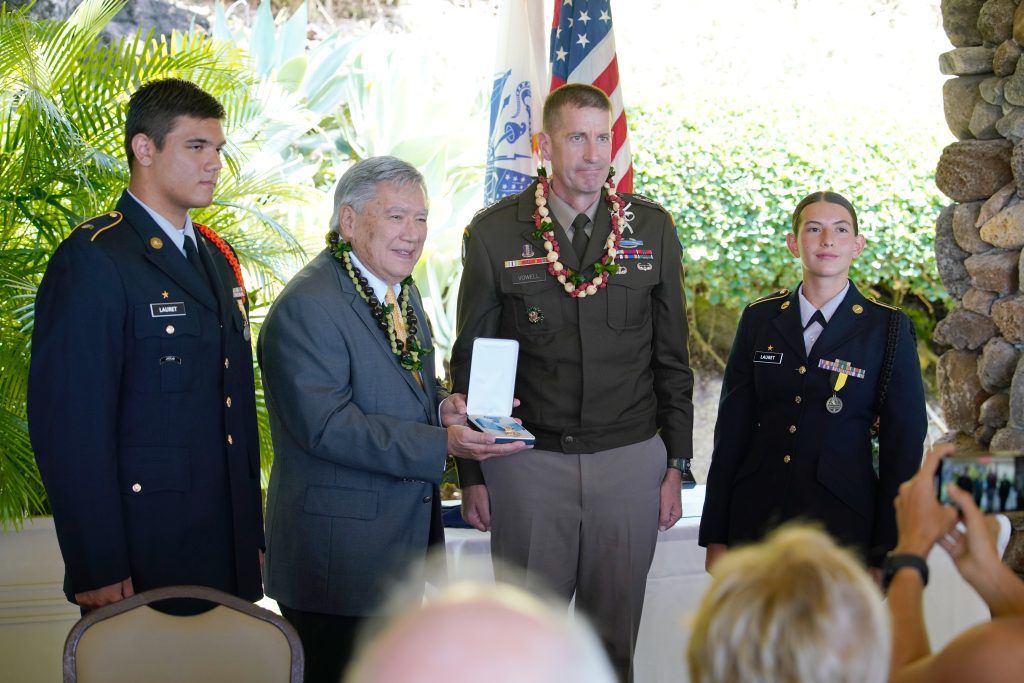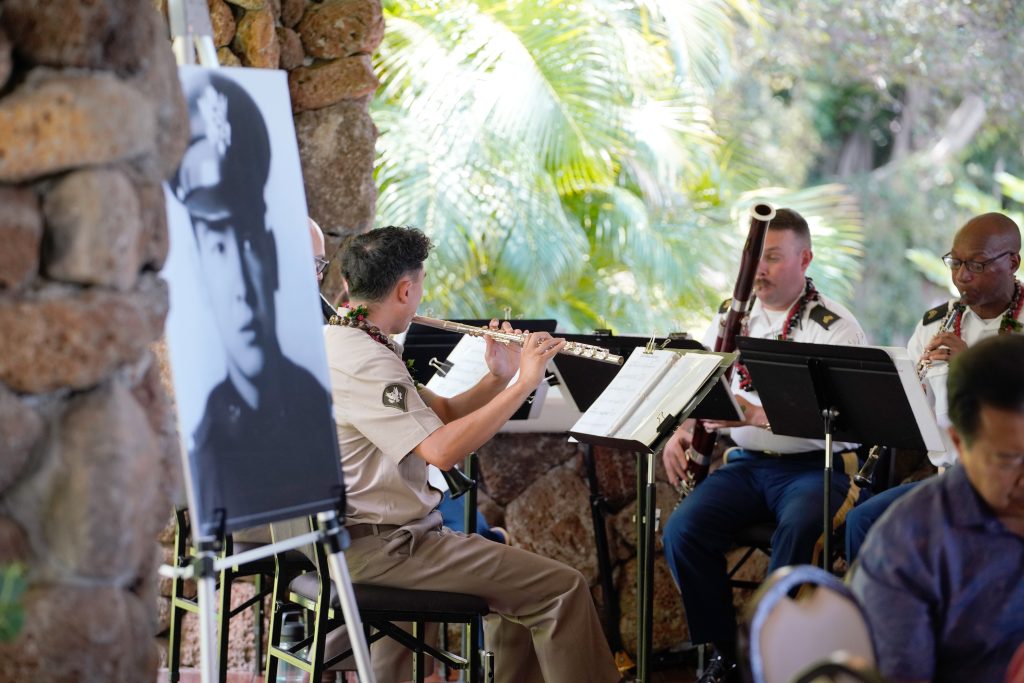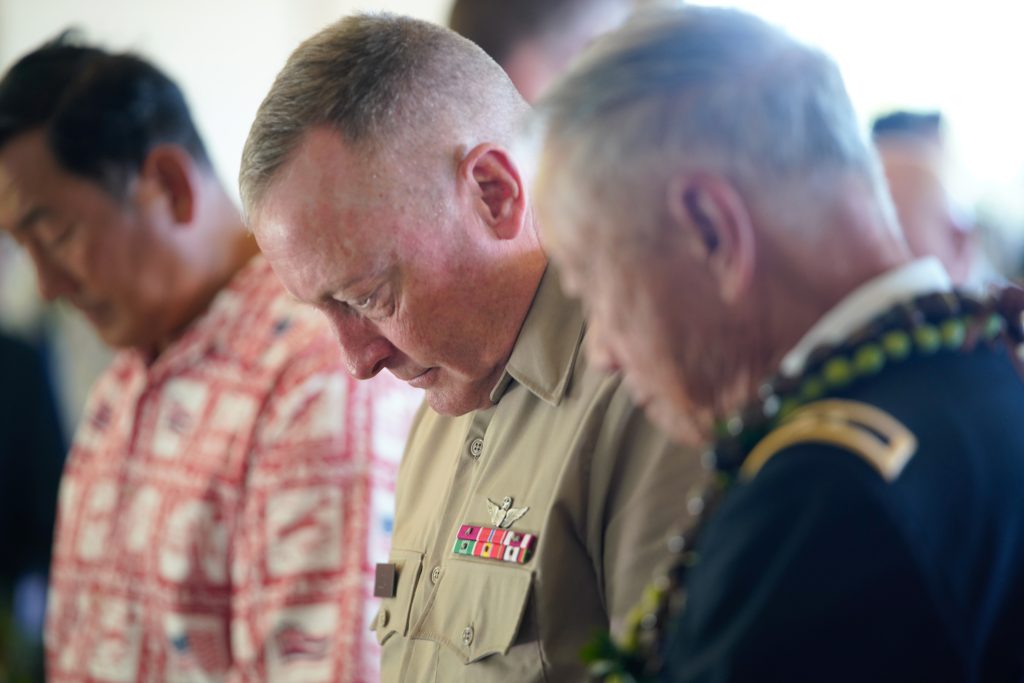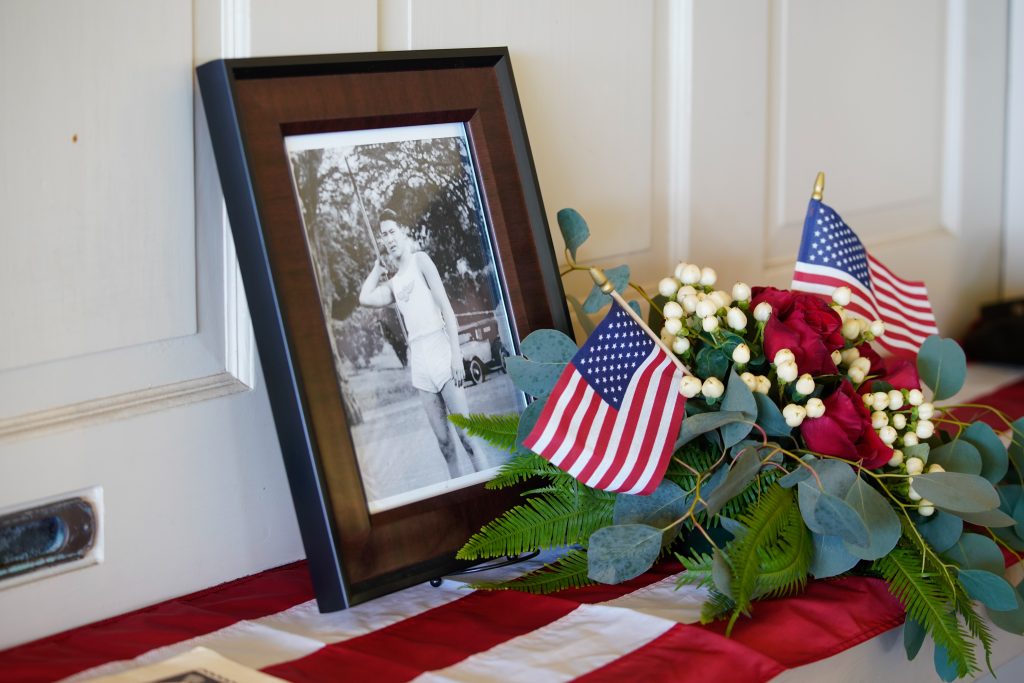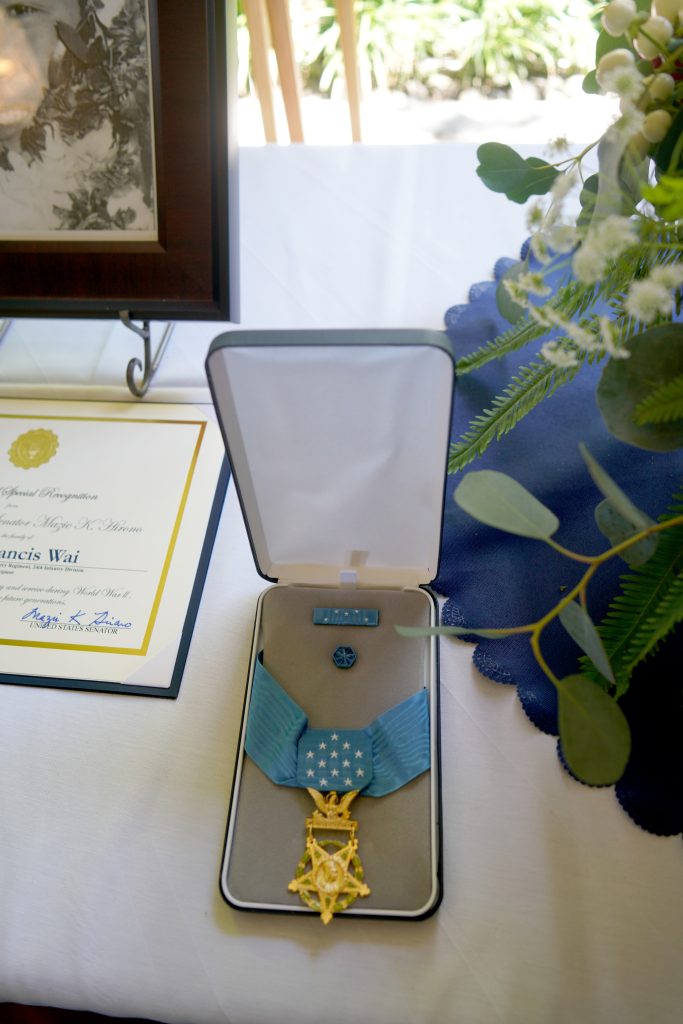Medal of Honor
The Medal of Honor is the highest military decoration that may be awarded by the United States government.
It is presented by the President of the United States, in the name of Congress, and is conferred only upon members of the United States Armed Forces who distinguish themselves through conspicuous gallantry and intrepidity at the risk of life above and beyond the call of duty:
While engaged in action against an enemy of the United States;
While engaged in military operations involving conflict with an opposing foreign force; or
While serving with friendly foreign forces engaged in an armed conflict against an opposing armed force in which the United States is not a belligerent party.
Over 3,400 Medals of Honor have been awarded to members of the Armed Forces and the Coast Guard since 1861 when it was first authorized.
World War II
Private Mikio Hasemoto
Pvt. Mikio “Kio” Hasemoto was born July 13, 1916 in Honolulu. He was killed in action at age 27 and is interred at Punchbowl: Sec. D, Grave 338. The 298th Infantry Soldier was assigned to the Hawaiian Provisional Infantry Battalion.
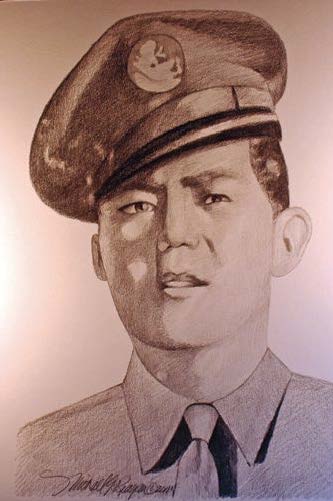
Citation The President of the U.S. of America, in the name of Congress, takes pride in presenting the Medal of Honor (Posthumously) to Private Mikio Hasemoto, U.S. Army, for conspicuous gallantry and intrepidity in action above and beyond the call of duty while serving with Company B, 100th Infantry Battalion (Separate), attached to the 34th Infantry Division, in action against the enemy on Nov. 29, 1943, in the vicinity of Cerasuolo, Italy.
Private Mikio Hasemoto distinguished himself by extraordinary heroism in action on 29 November 1943, in the vicinity of Cerasuolo, Italy. A force of approximately 40 enemy soldiers, armed with machine guns, machine pistols, rifles, and grenades, attacked the left flank of his platoon. Two enemy soldiers with machine guns advanced forward, firing their weapons. Private Hasemoto, an automatic rifleman, challenged these two machine gunners. After firing four magazines at the approaching enemy, his weapon was shot and damaged. Unhesitatingly, he ran 10 yards to the rear, secured another automatic rifle and continued to fire until his weapon jammed. At this point, Private Hasemoto and his squad leader had killed approximately 20 enemy soldiers. Again, Private Hasemoto ran through a barrage of enemy machine gun fire to pick up an M-1 rifle. Continuing their fire, Private Hasemoto and his squad leader killed 10 more enemy soldiers. With only three enemy soldiers left, he and his squad leader charged courageously forward, killing one, wounding one, and capturing another. The following day, Private Hasemoto continued to repel enemy attacks until he was killed by enemy fire. Private Hasemoto’s extraordinary heroism and devotion to duty are in keeping with the highest traditions of military service and reflect great credit on him, his unit, and the United States Army.
https://www.army.mil/medalofhonor/citations21.html#H
Articles
https://www.nationalww2museum.org/war/articles/private-mikio-hasemotos-belated-medal-honor
Captain Francis B. Wai
Capt. Francis B. Wai was born April 14, 1917 in Honolulu and was killed in action Oct. 20, 1944 at age 27 in Leyte, Philippines. After graduating college Wai joined the 298th Infantry prior to it’s Oct. 15, 1940 mobilization and was one of the officers pulled from the 298th to augment the active duty’s 34th Infantry Regiment, 24th Infantry Division. He is the only Medal of Honor recipient of Chinese ancestry. His is buried at Punchbowl: Section Q, Grave 1194
Citation The President of the U.S. of America, in the name of Congress, takes pride in presenting the Medal of Honor (Posthumously) to Captain (Infantry) Francis B. Wai, U.S. Army, for conspicuous gallantry and intrepidity in action above and beyond the call of duty while serving with Headquarters, 34th Infantry Regiment, 24th Infantry Division, in action against the enemy on Oct. 20, 1944, at Leyte, Philippine Islands.
Captain Francis B. Wai distinguished himself by extraordinary heroism in action, on 20 October 1944, in Leyte, Philippine Islands. Captain Wai landed at Red Beach, Leyte, in the face of accurate, concentrated enemy fire from gun positions advantageously located in a palm grove bounded by submerged rice paddies. Finding the first four waves of American soldiers leaderless, disorganized, and pinned down on the open beach, he immediately assumed command. Issuing clear and concise orders, and disregarding heavy enemy machine gun and rifle fire, he began to move inland through the rice paddies without cover. The men, inspired by his cool demeanor and heroic example, rose from their positions and followed him. During the advance, Captain Wai repeatedly determined the locations of enemy strong points by deliberately exposing himself to draw their fire. In leading an assault upon the last remaining Japanese pillbox in the area, he was killed by its occupants. Captain Wai’s courageous, aggressive leadership inspired the men, even after his death, to advance and destroy the enemy. His intrepid and determined efforts were largely responsible for the rapidity with which the initial beachhead was secured. Captain Wai’s extraordinary heroism and devotion to duty are in keeping with the highest traditions of military service and reflect great credit on him, his unit, and the United States Army.
https://www.army.mil/medalofhonor/citations23.html
Articles
https://www.thenmusa.org/biographies/francis-b-wai
Technical Sergeant Yeiki Kobashigawa
Tech. Sgt. Yeiki Kobashigawa, born Sept. 28, 1917 in Waiakea (Hilo), Hawaiʻi lived in Honolulu until his death Mar. 31, 2005 at age 87. His ashes are at Punchbowl: Court 8, Wall E, Row 500, Niche 536. The 298th Infantry Soldier was assigned to the Hawaiian Provisional Infantry Battalion. Kobashigawa, who received a battlefield commission, was one of only a handful still alive in 2000 to receive the Medal during a White House ceremony. After the war, Kobashigawa worked as a maintenance mechanic.
DOD Medal of Honor Monday Article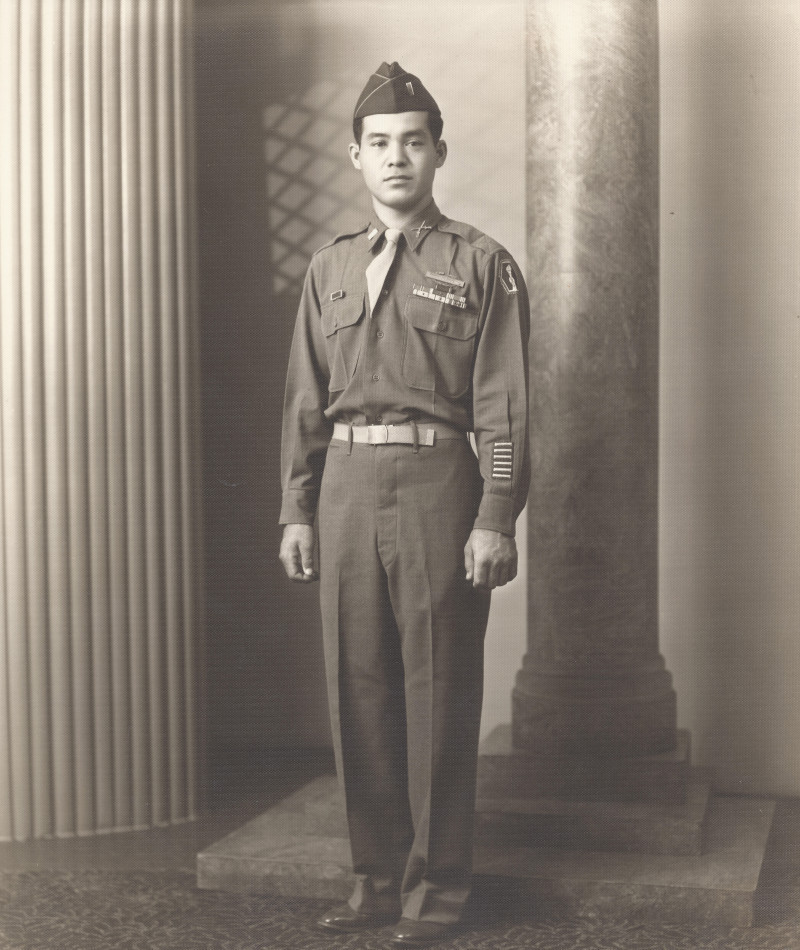
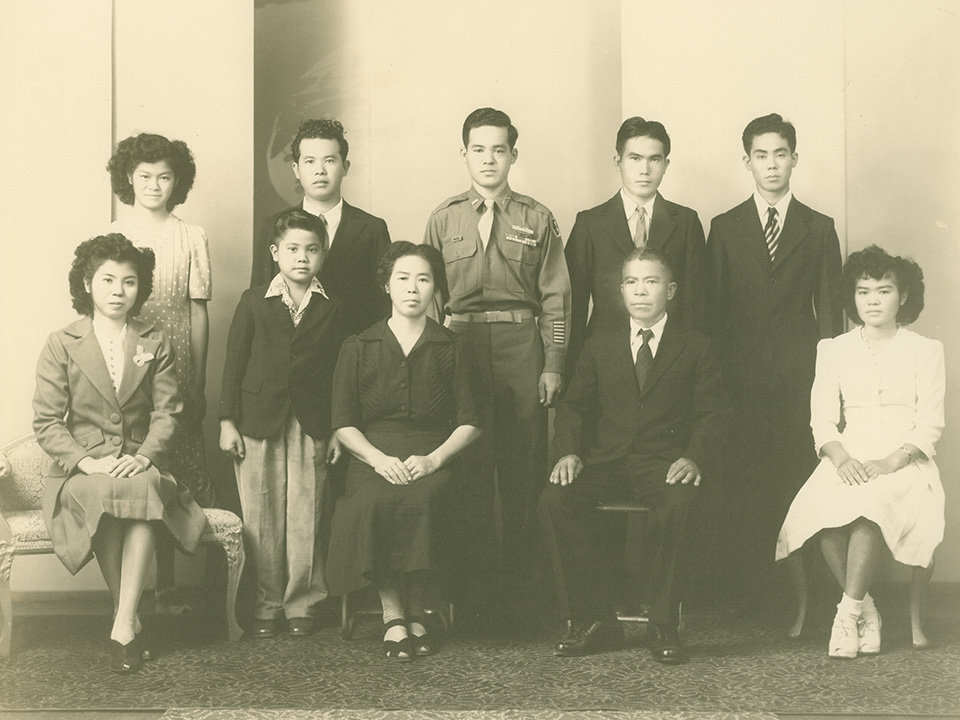
Citation The President of the U.S. of America, in the name of Congress, takes pleasure in presenting the Medal of Honor to Technical Sergeant Yeiki Kobashigawa, United States Army, for conspicuous gallantry and intrepidity in action above and beyond the call of duty while serving with Company B, 100th Infantry Battalion (Separate), attached to the 34th Infantry Division, in action against the enemy on Jun. 2, 1944, in the vicinity of Lanuvio, Italy.
Technical Sergeant Yeiki Kobashigawa distinguished himself by extraordinary heroism in action on 2 June 1944, in the vicinity of Lanuvio, Italy. During an attack, Technical Sergeant Kobashigawa’s platoon encountered strong enemy resistance from a series of machine guns providing supporting fire. Observing a machine gun nest 50 yards from his position, Technical Sergeant Kobashigawa crawled forward with one of his men, threw a grenade and then charged the enemy with his submachine gun while a fellow soldier provided covering fire. He killed one enemy soldier and captured two prisoners. Meanwhile, Technical Sergeant Kobashigawa and his comrade were fired upon by another machine gun 50 yards ahead. Directing a squad to advance to his first position, Technical Sergeant Kobashigawa again moved forward with a fellow soldier to subdue the second machine gun nest. After throwing grenades into the position, Technical Sergeant Kobashigawa provided close supporting fire while a fellow soldier charged, capturing four prisoners. On the alert for other machine gun nests, Technical Sergeant Kobashigawa discovered four more, and skillfully led a squad in neutralizing two of them. Technical Sergeant Kobashigawa’s extraordinary heroism and devotion to duty are in keeping with the highest traditions of military service and reflect great credit on him, his unit, and the United States Army.
https://www.army.mil/medalofhonor/citations21.html#K
Articles
https://www.nationalww2museum.org/war/articles/yeiki-kobashigawa-medal-of-honor
Sergeant Allan M. Ohata
Staff Sgt. Allan M. Ohata, born Sept. 13, 1918 in Honolulu, was one of the 40 original Japanese members of the Hawaiʻi National Guard Soldiers from the 298th Infantry to be mobilized Oct. 15, 1940. He received a battlefield commission, eventually was promoted to captain and became one of the Co. B, 100th Bn. (Sep) commanders. Ohata was unable to personally receive his upgraded award; he had died 23 years earlier. He lived in Aiea until his death Oct. 17, 1977 at age 59 and is buried at Punchbowl: Section 3, Grave 474.
DOD Medal of Honor ArticleCitation The President of the U.S. of America in the name of Congress, takes pleasure in presenting the Medal of Honor to Staff Sergeant Allan M. Ohata, U.S. Army, for conspicuous gallantry and intrepidity in action above and beyond the call of duty while serving with Company B, 100th Infantry Battalion (Separate), attached to the 34th Infantry Division, in action against the enemy on Nov. 29 and 30, 1943, near Cerasuolo, Italy.
Sergeant Allan M. Ohata distinguished himself by extraordinary heroism in action on 29 and 30 November 1943, near Cerasuolo, Italy. Sergeant Ohata, his squad leader, and three men were ordered to protect his platoon’s left flank against an attacking enemy force of 40 men, armed with machine guns, machine pistols, and rifles. He posted one of his men, an automatic rifleman, on the extreme left, 15 yards from his own position. Taking his position, Sergeant Ohata delivered effective fire against the advancing enemy. The man to his left called for assistance when his automatic rifle was shot and damaged. With utter disregard for his personal safety, Sergeant Ohata left his position and advanced 15 yards through heavy machine gun fire. Reaching his comrade’s position, he immediately fired upon the enemy, killing 10 enemy soldiers and successfully covering his comrade’s withdrawal to replace his damaged weapon. Sergeant Ohata and the automatic rifleman held their position and killed 37 enemy soldiers. Both men then charged the three remaining soldiers and captured them. Later, Sergeant Ohata and the automatic rifleman stopped another attacking force of 14, killing four and wounding three while the others fled. The following day he and the automatic rifleman held their flank with grim determination and staved off all attacks. Staff Sergeant Ohata’s extraordinary heroism and devotion to duty are in keeping with the highest traditions of military service and reflect great credit on him, his unit, and the United States Army.
https://www.army.mil/medalofhonor/citations22.html#O
Private Shinyei Nakamine
Private Shinyei Nakamine was born Jan. 21, 1929 in Waianae, Oahu and was killed in action at age 24, He is buried at Punchbowl: Section D, Grave 402. The 298th Infantry Soldier was assigned to the Hawaiian Provisional Infantry Battalion.
Citation The President of the U.S. of America, in the name of Congress, takes pride in presenting the Medal of Honor to Private Shinyei Nakamine (Posthumously), U.S. Army, for conspicuous gallantry and intrepidity in action above and beyond the call of duty while serving with Company B, 100th Infantry Battalion (Separate), attached to the 34th Infantry Division, in action against the enemy on Jun. 2, 1944, near La Torreto, Italy.
Private Shinyei Nakamine distinguished himself by extraordinary heroism in action on 2 June 1944, near La Torreto, Italy. During an attack, Private Nakamine’s platoon became pinned down by intense machine gun crossfire from a small knoll 200 yards to the front. On his own initiative, Private Nakamine crawled toward one of the hostile weapons. Reaching a point 25 yards from the enemy, he charged the machine gun nest, firing his submachine gun, and killed three enemy soldiers and captured two. Later that afternoon, Private Nakamine discovered an enemy soldier on the right flank of his platoon’s position. Crawling 25 yards from his position, Private Nakamine opened fire and killed the soldier. Then, seeing a machine gun nest to his front approximately 75 yards away, he returned to his platoon and led an automatic rifle team toward the enemy. Under covering fire from his team, Private Nakamine crawled to a point 25 yards from the nest and threw hand grenades at the enemy soldiers, wounding one and capturing four. Spotting another machine gun nest 100 yards to his right flank, he led the automatic rifle team toward the hostile position but was killed by a burst of machine gun fire. Private Nakamine’s extraordinary heroism and devotion to duty are in keeping with the highest traditions of military service and reflect great credit on him, his unit, and the United States Army
https://www.army.mil/medalofhonor/citations22.html#N
Private Masato Nakae
Private Masato “Curly” Nakae was born Dec. 20, 1917 in Haena (Lihue), Kauai, He was unable to personally receive his upgraded award, he had died two years earlier. He lived in Honolulu until his death Sept. 4, 1998 at age 80, and is buried at Punchbowl: Section U. Grave 1446. The 298th Infantry Soldier was assigned to the Hawaiian Provisional Infantry Battalion.
Citation The President of the U.S. of America, in the name of Congress, takes pleasure in presenting the Medal of Honor to Private Masato Nakae (deceased), U.S. Army, for conspicuous gallantry and intrepidity in action above and beyond the call of duty while serving with Company A, 100th Infantry Battalion, 442d Regimental Combat Team, attached to the 36th Infantry Division, in action against the enemy on Aug. 19, 1944, near Pisa, Italy.
Private Masato Nakae distinguished himself by extraordinary heroism in action on 19 August 1944, near Pisa, Italy. When his submachine gun was damaged by a shell fragment during a fierce attack by a superior enemy force, Private Nakae quickly picked up his wounded comrade’s M-1 rifle and fired rifle grenades at the steadily advancing enemy. As the hostile force continued to close in on his position, Private Nakae threw six grenades and forced them to withdraw. During a concentrated enemy mortar barrage that preceded the next assault by the enemy force, a mortar shell fragment seriously wounded Private Nakae. Despite his injury, he refused to surrender his position and continued firing at the advancing enemy. By inflicting heavy casualties on the enemy force, he finally succeeded in breaking up the attack and caused the enemy to withdraw. Private Nakae’s extraordinary heroism and devotion to duty are in keeping with the highest traditions of military service and reflect great credit on him, his unit, and the United States Army.
https://www.army.mil/medalofhonor/citations22.html#N
Private First Class Kaoru Moto
PFC Karou Moto, born Apr. 25, 1917 in Spreckeksville, Maui. The 298th Infantry Soldier was assigned to the Hawaiian Provisional Infantry Battalion. Moto donated all of his medals to the Fort DeRussy Army Museum before he died at age 75 in Makawao, Maui on Aug. 26, 1992. In 2004, the Pacific Army Reserve named the 32-year old Maui Army Reserve Center in Wailuku after Moto. He is interred at Punchbowl: Court 2, Wall F, Row 400, Niche 422
Citation The President of the U.S. of America, in the name of Congress, takes pride in presenting the Medal of Honor (deceased) to Private First Class Kaoru Moto, United States Army, for conspicuous gallantry and intrepidity in action above and beyond the call of duty while serving with Company C, 100th Infantry Battalion (Separate), attached to the 34th Infantry Division, in action against the enemy on July 7, 1944, near Castellina, Italy.
Private First Class Kaoru Moto distinguished himself by extraordinary heroism in action on 7 July 1944, near Castellina, Italy. While serving as first scout, Private First Class Moto observed a machine gun nest that was hindering his platoon’s progress. On his own initiative, he made his way to a point ten paces from the hostile position, and killed the enemy machine gunner. Immediately, the enemy assistant gunner opened fire in the direction of Private First Class Moto. Crawling to the rear of the position, Private First Class Moto surprised the enemy soldier, who quickly surrendered. Taking his prisoner with him, Private First Class Moto took a position a few yards from a house to prevent the enemy from using the building as an observation post. While guarding the house and his prisoner, he observed an enemy machine gun team moving into position. He engaged them, and with deadly fire forced the enemy to withdraw. An enemy sniper located in another house fired at Private First Class Moto, severely wounding him. Applying first aid to his wound, he changed position to elude the sniper fire and to advance. Finally relieved of his position, he made his way to the rear for treatment. Crossing a road, he spotted an enemy machine gun nest. Opening fire, he wounded two of the three soldiers occupying the position. Not satisfied with this accomplishment, he then crawled forward to a better position and ordered the enemy soldier to surrender. Receiving no answer, Private First Class Moto fired at the position, and the soldiers surrendered. Private First Class Moto’s extraordinary heroism and devotion to duty are in keeping with the highest traditions of military service and reflect great credit on him, his unit, and the United States Army.
https://www.army.mil/medalofhonor/citations22.html#M
Private Shizuya Hayashi
Private Shizuya “Ceasar” Hayashi was born Nov. 28, 1917 in Waiakea (Waialua), Oahu, He died Mar. 12, 2008, at age 90 and is buried at Punchbowl: Sec. 5, Grave 464. The 298th Infantry Soldier was assigned to the Hawaiian Provisional Infantry Battalion. He was the only Distinguished Service Cross recipient of the battle at Cerasuolo to survive to wear his upgraded Medal of Honor. As President Clinton hung our Nation’s highest award around his neck, he called to remembrance the heroism of his comrades, accepting his award on behalf of those who didn’t survive to see the historic White House ceremony.
Citation The President of the U.S. of America, in the name of Congress, takes pleasure in presenting the Medal of Honor to Private Shizuya Hayashi, U.S. Army, for conspicuous gallantry and intrepidity in action above and beyond the call of duty while serving with Company A, 100th Infantry Battalion (Separate), attached to the 34th Infantry Division, in action against the enemy on Nov. 29, 1943, near Cerasuolo, Italy.
Private Shizuya Hayashi distinguished himself by extraordinary heroism in action on 29 November 1943, near Cerasuolo, Italy. During a flank assault on high ground held by the enemy, Private Hayashi rose alone in the face of grenade, rifle, and machine gun fire. Firing his automatic rifle from the hip, he charged and overtook an enemy machine gun position, killing seven men in the nest and two more as they fled. After his platoon advanced 200 yards from this point, an enemy antiaircraft gun opened fire on the men. Private Hayashi returned fire at the hostile position, killing nine of the enemy, taking four prisoners, and forcing the remainder of the force to withdraw from the hill. Private Hayashi’s extraordinary heroism and devotion to duty are in keeping with the highest traditions of military service and reflect great credit on him, his unit, and the United States Army.
https://www.army.mil/medalofhonor/citations21.html#H
Articles
Korea
Private First Class Anthony T. Kaho’ohanohano
Pfc. Anthony T. Kaho’ohanohano was born July 22, 1930 in Wailuku, Maui and was killed in action September 1, 1951 at age 21 in Chupa-ri, Korea. Camp Paukukaloa, Maui’ pistol and machine gun range is named Kahoohanohano Range after the former Heavy Mortar Company, 299th Infantry Soldier, who is buried at the Maui Veterans Cemetery.
DOD Medal of Honor ArticleYears of Service: 3 years, 3 months, prior service with Hawaiʻi National Guard. Enlisted with the U.S. Army Feb. 5, 1951
Awards: Purple Heart (posthumously), Army Good Conduct Medal (posthumously), National Defense Service Medal, Korean Service Medal with one Bronze Service Star, United Nations Service Medal, Republic of Korean-Korean War Service Medal, The Republic of Korea’s Wharang Distinguished Military Service Medal with Silver Star (posthumously), Combat Infantryman Badge, Republic of Korea-Presidential Unit Citation
Citation The President of the U.S. of America in the name of Congress, takes pleasure in presenting the Medal of Honor to (Posthumously) to Private First Class Anthony T. Kahoohanohano, U.S. Army, for extraordinary heroism in connection with military operations against an armed enemy of the United Nations while serving with Company H, 2nd Battalion, 17th Infantry Regiment, 7th Infantry Division.
Private First Class Anthony T. Kaho’ohanohano, Company H, 17th Infantry Regiment, 7th Infantry Division, distinguished himself by extraordinary heroism in action against the enemy in the vicinity of Chupa-ri, Korea, on 1 September 1951. On that date, Private First Class Kaho’ohanohano was in charge of a machine-gun squad supporting the defensive positioning of Company F when a numerically superior enemy force launched a fierce attack. Because of the enemy’s overwhelming numbers, friendly troops were forced to execute a limited withdrawal. As the men fell back, Private First Class Kaho’ohanohano ordered his squad to take up more defensible positions and provide covering fire for the withdrawing friendly force. Although having been wounded in the shoulder during the initial enemy assault, Private First Class Kaho’ohanohano gathered a supply of grenades and ammunition and returned to his original position to face the enemy alone. As the hostile troops concentrated their strength against his emplacement in an effort to overrun it, Private First Class Kaho’ohanohano fought fiercely and courageously, delivering deadly accurate fire into the ranks of the onrushing enemy. When his ammunition was depleted, he engaged the enemy in hand-to-hand combat until he was killed. Private First Class Kaho’ohanohano’s heroic stand so inspired his comrades that they launched a counterattack that completely repulsed the enemy. Upon reaching Private First Class Kaho’ohanohano’s emplacement, friendly troops discovered 11 enemy soldiers lying dead in front of the emplacement and two inside it, killed in hand-to-hand combat. Private First Class Kaho’ohanohano’s extraordinary heroism and selfless devotion to duty are in keeping with the finest traditions of military service and reflect great credit upon himself, the 7th Infantry Division, and the United States Army.
https://www.army.mil/article/55395/
Articles
https://www.dvidshub.net/image/3864378/armory-memorialization-ceremony
https://dod.hawaii.gov/retireenews/files/2017/10/101717-kahoohanohano-story.pdf
